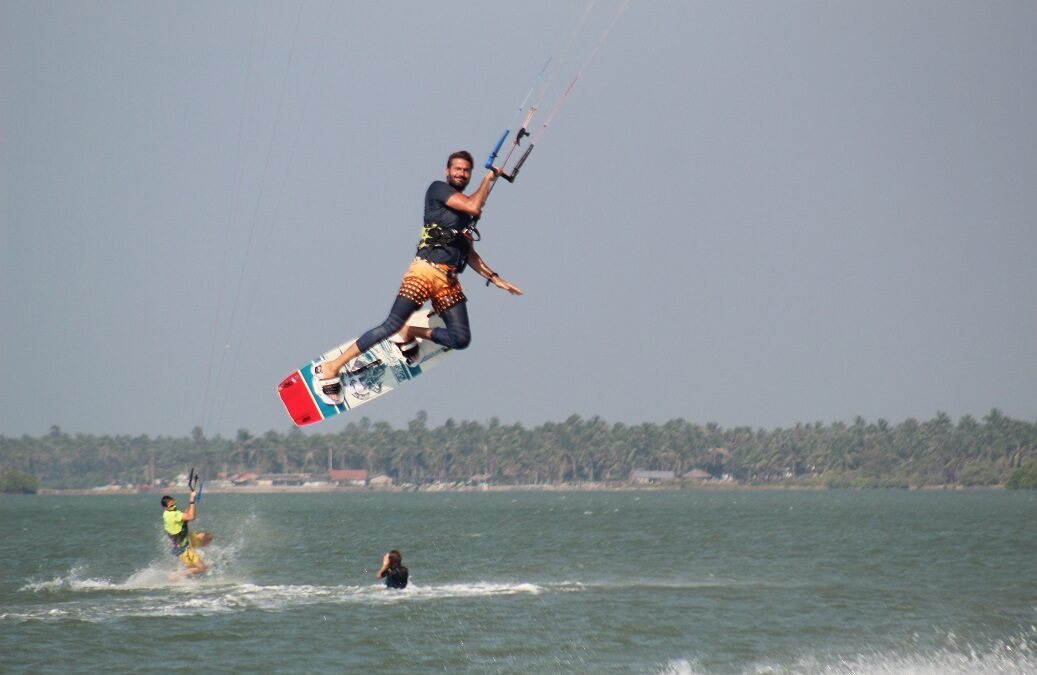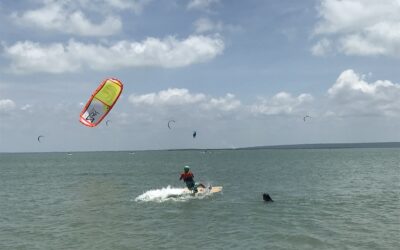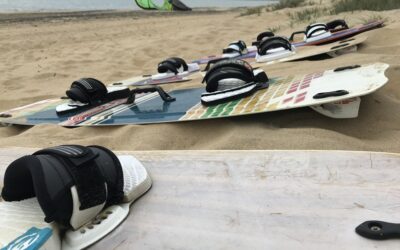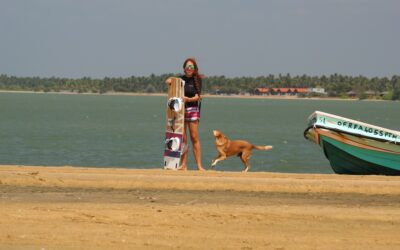Did you know that performing a kite jump is the best sensation that this sport can offer you? Jumping is probably the kite trick that offers the most feeling of freedom. For that reason, we have developed this guide on how to learn to jump in kitesurfing. Do you want to learn how to jump? In this article, we will explain how to kite jump step by step. We hope that these tips will be of great use to you to start with your baby jumps. However, you must bear in mind that before trying your first kite jumps, you must have enough confidence and level; otherwise, you can lose control of your kite.
Jumping is actually the next step of your progression once you already know how to ride upwind and you master some other basic skills like riding toeside or making transitions. Take a look at our guide on the best kite tricks for beginners
In the event you don´t like the feeling of jumping, you can always do strapless, race or kitesurf calmly, but we recommend you to try at least once to see what is like being up in the air. We assure you that it will not leave you indifferent. Have you ever dreamed of flying like a bird? Then this is probably the closest thing to flying.
Before go into how to perform a proper jump, let´s see the minimum requirements. As we have remarked, you need a minimum condition, knowledge and experience if you don´t want to end up with a serious setback like a broken kite or even worst…..
>> Come to Sri Lanka and learn how to jump with Margarita´s team!
- Before attempting your first jump, you need to have a few things under control. You have to be able to relaunch the kite when it falls, you have to know how to upwind, navigate against the wind and you have to know how to recover the board in body dragging upwind. These are essential principles for attempting your first jump. We recommend you do not rush, or you may end up becoming afraid of this sport.
- You have to know about your kite position at all times. Unintentionally, powering the kite and ending up being pulled by it uncontrollably is a common situation at first.
- You need optimal wind conditions, neither too strong nor too light; look at the range of your kite and try to practice with the measure that is in its average range. From 12 to 18 knots is the perfect range to learn to jump. Also, it is a must you evaluate the direction of the wind. Side on is the most suitable wind direction. Remember: never try your first jumps if you are too near the shore cause once in the air you will shift many meters downwind. ( water doesn’t hurt, but sand does …)
- Choose a flatwater kite spot without waves. Waves can be tricky, although at the beginning they can help you jump (make a ramp for it), they can be detrimental to the jump reception, besides not allowing you to perform the jump technique as it should. Also, remember you need deep water, at least one meter up.
- Last but not least, adjust your footstrap properly. They don’t have to be too narrow but not too loose. Something in between, you have to be able to remove the board at any time.
5 Advanced Kitesurfing Tricks You Can Try Today!
5 Advanced Kitesurfing Tricks You Can Try Today! So you have mastered the basic and mid-level kitesurfing and now looking to step up your skills? The surprising thing about kitesurfing is that there is always something to learn, no matter how skilled you are!...
How difficult is it to learn kitesurfing ? Is it hard to learn?
One of the most crucial questions that somebody who is up to learn kitesurfing is; Is kitesurfing easy to learn? How hard is it to learn to kitesurf? Can you learn kitesurfing on your own? Well, let us tell you that kitesurfing is not a sport which is really hard to...
How much does it cost to learn kitesurfing? Kitesurfing lessons cost
Are you wondering how much does it cost to start kitesurfing? In this article you will find out how much does it cost to start kitesurfing, own your own equipment and to continue practising on the kite beach without an instructor. When countless colorful kites fly...
The technique of kite jumps step by step.
Here you have the 3 basics of the kiteboarding jumps. Each step is very important to perform a correct jump
1. Riding upwind at constant seed
Riding with the correct position is the first thing you should take in mind if you want to master the kite jump technique. You must control the correct position, with the front leg stretched and the back more flexed, and the edge of the board stuck in the water making pressure to carve against the wind.
Locate your kite around 11 or 13 depending on the direction you have; the closer the kite is to 12 o’clock, the lower the jump will be. Keep all the time riding upwind to perform a proper take-off.
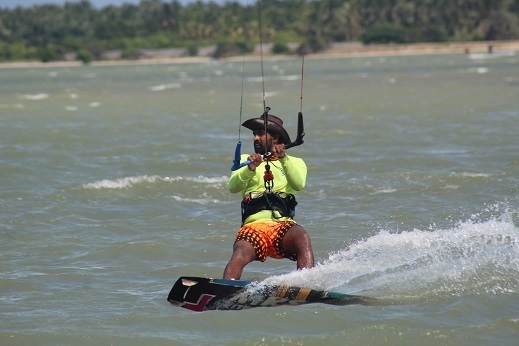
In this pic, you can see Rasikha having the right position with the front leg stretched & back leg bent and his body laying backwards before attempting to jump
2. Taking-off
When you want to jump, you will have to make a quick turn of the bar to take the kite towards 12 o’clock. By moving the kite up, you will make tension on the lines and ultimately the lift.
As the kite heads towards the zenith (12), bring the bar towards you to give maximum power. Do it gradually, so you don’t go into power until it’s close to 12.
Before you feel the first push of the kite, you must make resistance with your board so as not to advance further, neither towards the direction you were taking nor towards the direction of the kite.
It is crucial to do the kite turn, bar power and resistance of the board in a coordinated way. It is not all at once, but it is gradually.
Once you start ascending, you must remain calm at all times and prepare the kite to reposition it in the direction you were going. At those times, you will have to keep your balance in the air and rush to reposition the kite at 11 or 13 depending on your jump direction while releasing the bar to release power from the kite.
The speed of these movements will be according to the jump taken, that is, the higher the jump, the less rush we will make them.
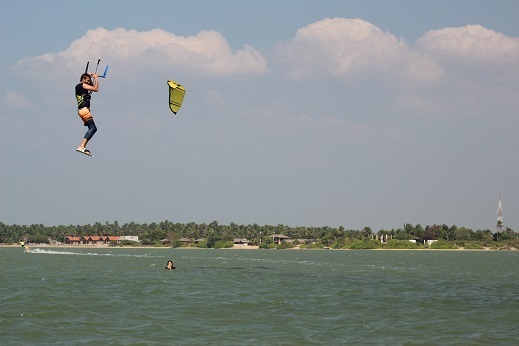
Once in the air, relocate again the kite to the direction you were riding. Here you can see Ruben balancing in the air controlling the kite with the proper pressure on the bar and preparing himself for landing, by pointing the kite to 1 o´clock.
3. Landing and Jump reception
When you are on your way down, detect your landing and straighten your legs to absorb the impact of it. You mustn’t lock your knees when landing, as it could hurt them on impact.
Begin to bend your knees to cushion the reception, always with the board slightly raised from the front so as not to sink into the water. Keep your knees slightly bent to help absorb shock.
The board has to point downwind not to create resistance. Once you have landed softly and everything is under control, you can start carving again and continue riding upwind.
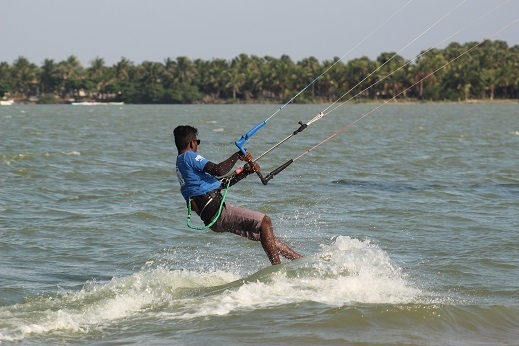
Chattu performing his jump reception, pointing the board slightly downwind and preparing himself for carving again upwind
The Top 10 kitesurfing tricks for beginners
A couple of weeks into your kitesurfing lessons, you feel confident. The adrenaline rush drives you to learn new tricks. The fancy unhooked tricks attract you, yet, is it advisable? A big ‘No.’ Don’t worry; we got you covered. In this article, we guide you through 10...
Kitesurfing for beginners
The ultimate guide to Kitesurf for beginners Are you thinking of starting a new challenge in your life by learning to kitesurf? Here we leave you the perfect guide for beginners: from choosing the right teacher to buying the equipment. If you are just...
The ultimate guide to the best kites for beginners to learn kitesurf
The most suitable kites for beginners to get started Kitesurfing for beginners can prove to be an intimidating experience. Kiteboarding is an exhilarating and dynamic sport that requires an endless amount of skills and tricks to learn which at times becomes...
Remember:
* The faster you move the kite up, the more power you will get and ultimately the higher you will jump. Better you start not too aggressively. Safety first! You will have time to be braver once you get more confident
How much does kitesurfing equipment cost?
For many people who are new to kitesurfing and want to learn, a commonly asked question is how much kitesurfing gear costs. However, the answer to this question is not a straightforward one - The price of kitesurfing equipment varies between items and even between...
Kite gear maintenance: best practices for a long life of your kitesurfing equipment
Have you just started in the sport and still don't know very well how to keep your kitesurfing equipment in the best conditions? Your Kitesurfing equipment is very important, and if you love it and you want it to last for a long time, you must maintain it in the best...
The ultimate guide to beginner kitesurfing boards
Have you finished your kite course and you don't know which initiation board is the most suitable for beginners? In this post, we will help you to choose the best beginners kitesurfing boards and the ones which you can progress faster. There is always a hard time in...
Tips and recommendations to learn how to kite jump
It would be best if you didn´t miss anything, that´s why here we give you some advice about how to make the right jump and not to get hurt in the attempt.
1. Before starting with your first kite jumps, it will be beneficial to look at other kiters in the area; look at their movements and imitate them.
2. Start with small jumps, even if you have to do faster movements, you will make sure you do not hurt yourself in the fall.
3. As we told you at the beginning, secure your surroundings before doing it, if you see kiters nearby, better wait to find yourself alone.
4. Be careful with the gusts, one may appear at the most inappropriate moment, you will have to be prepared and mentalized for this inconvenience.
Common mistakes of beginners:
* I saw many students with the wrong body position when they attempt to jump. Have you ever seen one of these kiters attempting to jump and seeming like a frog? We call them flying frogs. Well, this is probably because they don´t have a good body position
Solution: Ride upwind with the right position. Stretch your front leg and bench your back leg before lifting.
* Riding overpowered or underpowered. This is another common mistake for those who are learning to kite jump. If you are completely overpowered, you will struggle a lot to keep your position. If you lose the carving and you ride downwind you will succeed. By the other hand, if you are underpowered, you won´t get enough power to jump.
Solution: Choose the proper kite size according to your weight and the wing range. If you are renting equipment and see that something goes wrong with your jump, ask for some advice to the instructors. Maybe you are doing everything well, and the problem is not you but the kite.
** Riding too fast: Remember, it is not about your speed what will make you go high, but the proper techniques with have explained you. Riding too fast will not make you fly higher but will make you lose control. If you want to go high is not about riding faster but to move the kite faster
– I’m not taking off!
You may move the kite too slowly and not create the lift. Move the kite faster.
You are not carving properly. If you don’t carve, you are not creating resistance to make the lift effect.
– I land without speed and stop.
You are forgetting to lower the kite back to the way you were riding
Here we leave you a summary about what we have discussed:
In order to kite jump, first, you must lean your body back to the water; this will help you acquire greater speed and have more stability. Remember to keep up your speed without being overpowered and to have the right body position. Once this is done, you can position the kite between 1 and 2 o’clock. Turn the kite quickly from 1 a.m. to 12 a.m. Then you’ll get to the point where enough tension has built up that you won’t be able to skirt any more and the kite will launch you out of the water.
Place your knees on your chest to help keep you stable and prevent you from swinging under the kite. This is the main key to getting your jumps in order. If you release your advantage too early, you will not achieve any height, much less reach the ground with speed.
Finally, once you are in the air, to land, you must make sure that the kite is above you, at 12 o’clock. When you are on your way down, detect your landing and straighten your legs to absorb the impact of it. It is important that you do not lock your knees when landing, as it could get hurt on impact.
Keep your knees bent to help absorb shock. About a meter above the dive in the water, position the kite around 1 or 2 o’clock where you were before starting the jump. This will give you forward momentum to make the landing smoother. Remember to place your right leg into the wind that propels your kite.
Above all, enjoy! Remember that kitesurfing is above all fun! All of us have always dreamed of being superman and flying over the sky! Of course, you are not going to jump very high in your first attempts, and you will probably spend most of your time relaunching the kite that has fallen or looking for the board in body dragging but does not worry, we have all been through this, it is just about continuing practising, and sooner or later you will have it super controlled.
Here we leave you a video to have a better idea about how to jump.

